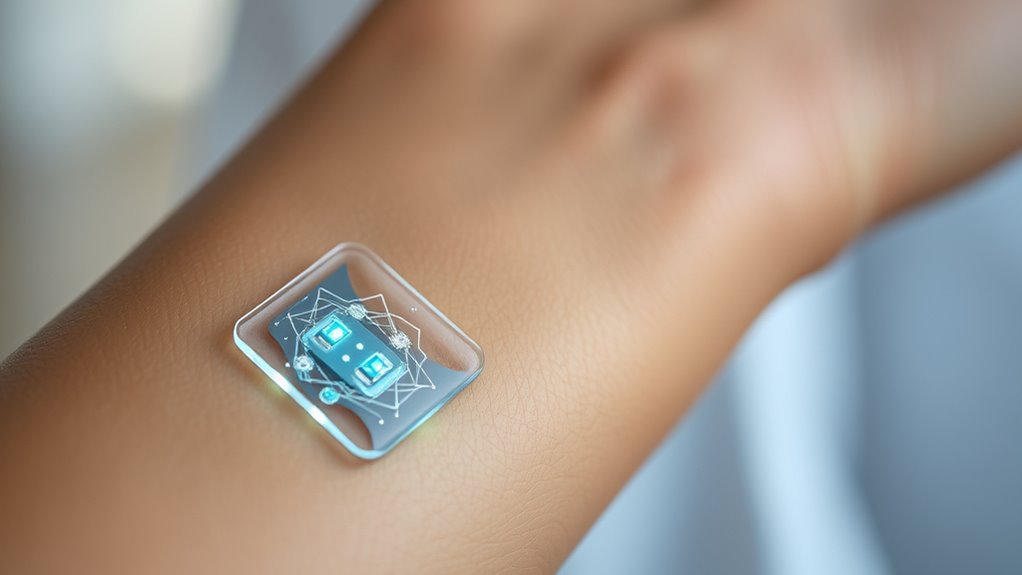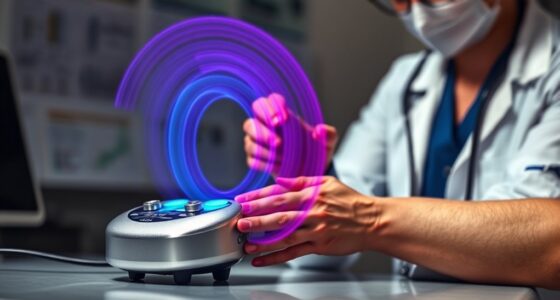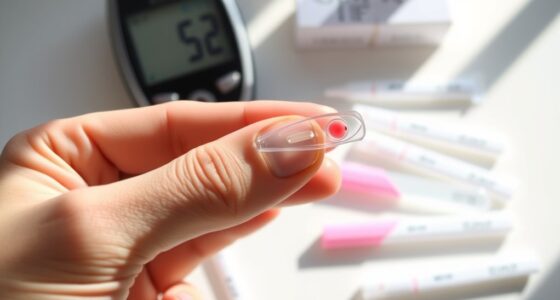Continuous glucose monitoring (CGM) for non-diabetics offers real-time insights into your blood sugar levels, helping you optimize your diet, lifestyle, and metabolic health. By tracking how foods, stress, and activity affect your glucose, you can fine-tune habits for better energy, focus, and long-term resilience. Advances in non-invasive sensors and AI-driven analysis make this tool more accessible and personalized than ever. Keep exploring, and you’ll discover how to harness CGM for peak biohacking performance.
Key Takeaways
- CGM provides real-time blood sugar data, enabling biohackers to optimize diet, fasting, and activity for better metabolic health.
- Non-invasive sensors like skin patches and optical devices are advancing, making tracking more comfortable and accessible.
- Analyzing glucose patterns helps identify food sensitivities, stress impacts, and lifestyle factors affecting metabolic flexibility.
- Proper sensor placement, calibration, and data security are essential for accurate readings and privacy protection.
- AI integration and seamless connectivity are enhancing personalized insights, empowering proactive health optimization.
What Is Continuous Glucose Monitoring and How Does It Work?
Continuous glucose monitoring (CGM) is a technology that tracks your blood sugar levels throughout the day and night in real time. It provides valuable insights into how your body responds to different foods, activities, and fasting. By monitoring these fluctuations, you can better understand your glucose sensitivity, which influences how effectively your body manages sugar. Increased metabolic flexibility means your body adapts efficiently to varying energy sources, and CGM helps you optimize this process. The device usually involves a small sensor inserted under your skin that transmits data wirelessly to your smartphone or reader. This real-time feedback allows you to make immediate adjustments to your diet and lifestyle, empowering you to enhance your overall metabolic health and better regulate blood sugar levels. Incorporating lifestyle factors such as stress management and sleep quality can further optimize your results. Additionally, some advanced devices are compatible with app-based platforms that analyze your data more comprehensively and suggest personalized adjustments. Understanding how risk mitigation techniques can influence your body’s energy response can also support your biohacking journey.
The Benefits of Using CGM for Non-Diabetic Users

Using a CGM offers non-diabetic individuals several significant benefits, especially when it comes to optimizing metabolic health. By tracking your glucose levels in real time, you gain insights that improve metabolic flexibility and hormone regulation. This awareness helps you identify how different foods, activities, and stressors impact your body, enabling smarter choices. You can fine-tune your diet to stabilize blood sugar and enhance energy levels throughout the day. Additionally, CGM data encourages consistent habits that support long-term metabolic balance. Recognizing the importance of mindful awareness can further support your efforts to optimize metabolic health, as cultivating creative practice enhances your ability to adapt and respond effectively to various health challenges. Understanding glucose variability can lead to more precise adjustments in your lifestyle. Embracing a positive mindset fosters resilience and motivation in your health journey. With this knowledge, you become more proactive in managing your health.
Choosing the Right CGM Device for Your Biohacking Goals
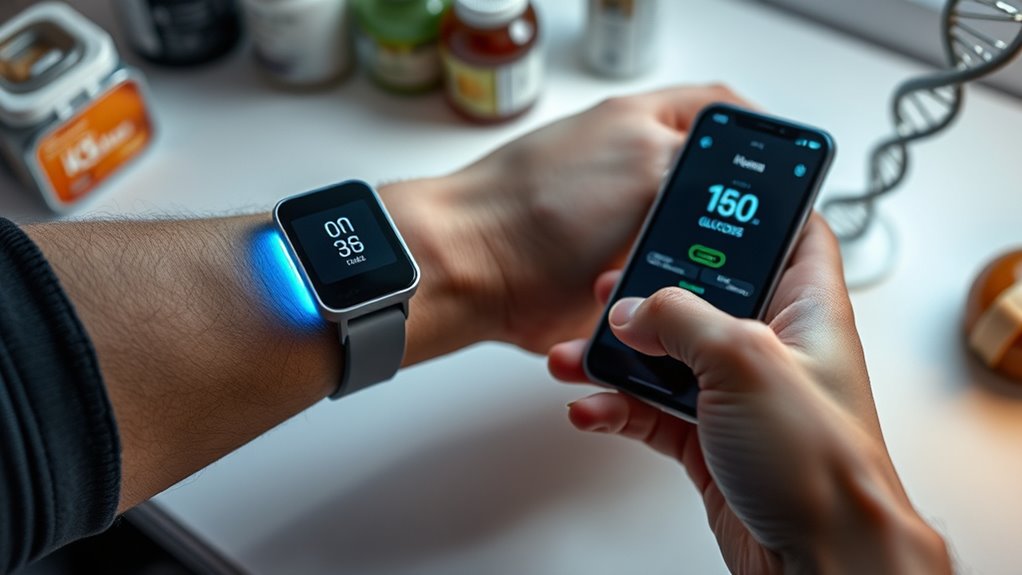
Choosing the right CGM device depends heavily on your specific biohacking goals and lifestyle. Consider sensor longevity; some devices last longer between replacements, reducing hassle. Device compatibility is also key—ensure it syncs seamlessly with your smartphone or other health apps. Additionally, assess whether the device provides real-time data access, which can be crucial for immediate adjustments and feedback during your biohacking routines. When selecting a device, also think about data security, especially if you’re sharing sensitive health information. To optimize your experience, look for devices that offer user-friendly interfaces and reliable data accuracy, aligning with your overall health optimization strategy. Being aware of security zone info can help you better understand how to protect your personal health data effectively.
Setting up and Getting Started With Your CGM System
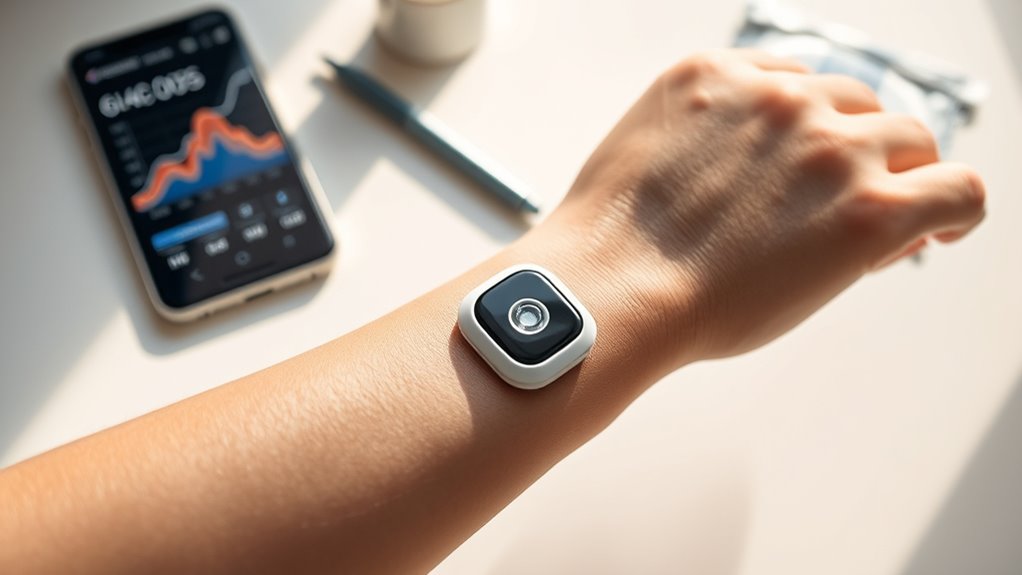
Getting started with your CGM system involves choosing the right device for your goals and ensuring proper sensor placement. You’ll also need to calibrate the sensor correctly and stay on top of regular maintenance. These steps will help you get accurate readings and make the most of your monitoring experience. Understanding the importance of sensor calibration can significantly impact the reliability of your data. Additionally, considering best devices for non-diabetics can help optimize your tracking experience. Proper sensor maintenance is essential for consistent performance and longevity of your CGM system. Exploring cost-effective options can also make ongoing monitoring more accessible and sustainable.
Selecting the Right Device
Selecting the right CGM device is essential to guarantee accurate readings and a comfortable experience. You want a device with good sensor durability to minimize replacements and maintenance. You consider the performance and reliability of the sensors, which can vary between brands and models. A device with sensor lifespan that matches your needs can reduce the frequency of sensor changes and improve your overall experience. Additionally, look into the storage and portability features of the device, ensuring it is easy to carry and store without damage. Consider the device aesthetics—choose one that feels discreet and matches your style, so you’re more likely to wear it consistently. Think about compatibility with your smartphone or other tools you use daily. Battery life matters; longer-lasting devices mean fewer interruptions. Finally, check user reviews for reliability and ease of use. Being aware of the pinball machine weight can also inform your understanding of device durability and transport considerations, especially if you plan to travel with your CGM system.
Proper Sensor Placement
Proper sensor placement is essential for accurate readings and comfort when using a CGM system. Start by selecting an area with minimal hair and few blood vessels, usually on your upper arm or abdomen. Before applying the sensor, prepare your skin with thorough skin preparation—clean the area with alcohol wipes to remove oils and dirt, ensuring good adhesion. Avoid applying lotion or lotion-based products before sensor placement, as they can interfere with adhesion and accuracy. Once the skin is clean and dry, carefully insert the sensor according to the manufacturer’s instructions, making sure it’s securely attached. Correct sensor placement and proper skin preparation prevent false readings and discomfort, setting you up for reliable, continuous glucose monitoring.
Calibration and Maintenance
Once you’ve applied your CGM sensor, the next step is to calibrate and set up your system properly to guarantee accurate readings. Proper sensor calibration ensures your device provides reliable data, while regular device maintenance keeps it functioning effectively. To get started:
- Follow manufacturer instructions for initial sensor calibration
- Record blood glucose readings during calibration for accuracy
- Keep the sensor clean and dry to prevent malfunctions
- Replace the sensor as recommended to maintain precision
- Check for software updates to improve device performance
Interpreting Glucose Data to Optimize Diet and Lifestyle
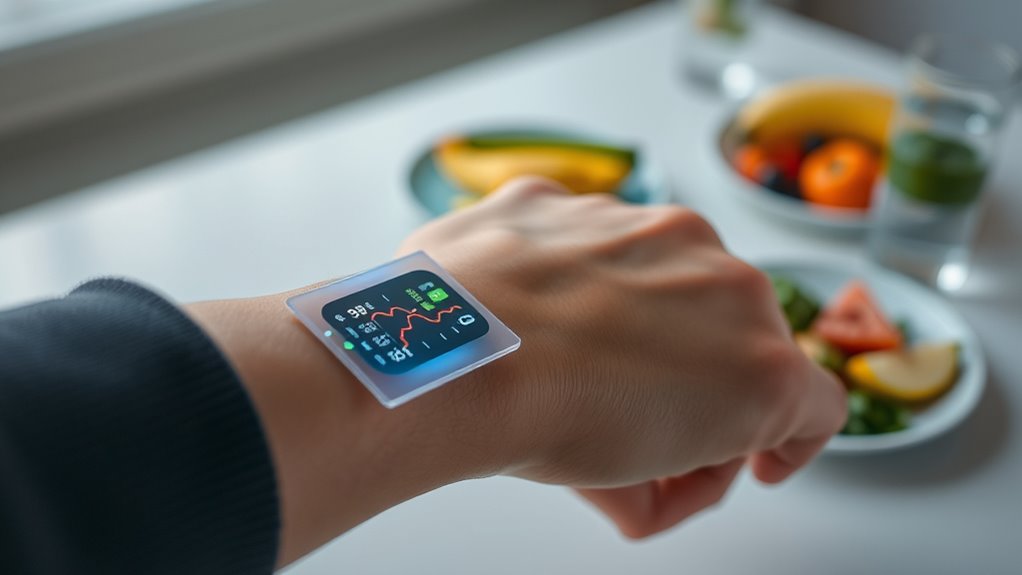
Interpreting glucose data accurately is essential for making meaningful adjustments to your diet and lifestyle. Tracking your glucose responses helps identify how specific foods, like carbs or fats, impact your levels. For example, if you’re following a ketogenic diet, monitoring your glucose guarantees you stay in ketosis and avoid spikes that could hinder fat-burning. Similarly, during intermittent fasting, understanding how your blood sugar fluctuates can help you optimize fasting periods and refeeding strategies. Look for patterns: consistent spikes after certain meals suggest you need to tweak ingredients or timing. Use your data to refine your approach, making small, informed changes that enhance energy, mental clarity, and metabolic health. Additionally, being aware of signs of spoilage in your food and beverages ensures you maintain a safe and healthy diet. Incorporating remote monitoring tools can help you track your glucose levels more effectively and stay motivated. Understanding food safety regulations related to food handling and storage can also help you make better choices and avoid contaminated products. Ultimately, clear interpretation empowers you to create a personalized, sustainable routine.
Practical Strategies for Managing Blood Sugar Fluctuations

To keep your blood sugar levels steady, start by optimizing your meal timing and choosing nutrient-rich foods. Incorporate activity to help regulate fluctuations, and pay attention to how different foods and exercise impact your glucose. These practical strategies can make managing blood sugar easier and more effective.
Meal Timing Optimization
Optimizing meal timing can considerably reduce blood sugar fluctuations, even for those without diabetes. By paying attention to when you eat and incorporating fasting windows, you can stabilize your blood sugar levels throughout the day. Consistent meal timing helps your body anticipate glucose intake, minimizing spikes and crashes. You might experiment with eating within a specific window each day or delaying meals to extend fasting periods. This approach can improve insulin sensitivity and energy levels. Remember, small adjustments can make a big difference. Focus on finding a routine that suits your lifestyle and supports your goals.
- Eat your meals at regular intervals
- Incorporate longer fasting windows (e.g., 16:8)
- Avoid late-night snacks
- Time carbs around activity periods
- Listen to your body’s hunger signals
Nutrient Balance Tips
Balancing your meals with the right mix of nutrients is key to managing blood sugar swings effectively. Focus on optimizing your meal composition by including all three macronutrients—protein, healthy fats, and complex carbs. Protein slows digestion and reduces glucose spikes, while healthy fats promote sustained energy and stabilize blood sugar levels. Incorporate fiber-rich foods like vegetables, whole grains, and legumes to further blunt rapid glucose increases. Avoid high-sugar, refined carbs that cause quick spikes. Instead, aim for balanced portions that provide steady energy without overwhelming your system. By paying attention to your macro nutrient balance, you can prevent large blood sugar fluctuations and promote more consistent, manageable levels throughout the day. Remember, thoughtful meal composition is a powerful tool in your biohacking toolkit.
Activity Impact Strategies
Incorporating physical activity into your routine can considerably influence blood sugar stability. Exercise impact is significant; regular movement helps improve insulin sensitivity and prevents spikes. To maximize benefits, try to balance activity with your daily schedule. For example:
- Take short walks after meals to stabilize blood sugar
- Incorporate high-intensity interval training (HIIT) a few times weekly
- Use resistance exercises to build muscle and enhance glucose uptake
- Prioritize consistent sleep quality for better metabolic regulation
- Avoid late-night workouts that might disrupt your sleep cycle
Integrating CGM Insights Into Your Daily Routine

To effectively integrate CGM insights into your daily routine, start by paying close attention to how your glucose levels respond to different foods, activities, and stressors. Track patterns and adjust your habits accordingly. Regular device maintenance ensures accurate readings, so keep your sensor calibrated as recommended, and replace it when needed. Consistent calibration helps avoid skewed data, making your insights more reliable. Use the data to identify which foods cause spikes and tailor your meals to maintain stable glucose levels. Incorporate quick stress-relief techniques during stressful moments to prevent spikes. Remember, integrating CGM insights is a continuous process; stay attentive and modify your routine accordingly.
| Food/Activity | Glucose Response | Adjustments Needed |
|---|---|---|
| High-carb meal | Spikes | Reduce portion, add fiber |
| Exercise | Drop | Incorporate post-workout carbs |
| Stress | Rise | Practice breathing or meditation |
| Fasting | Stable | Maintain consistency |
| Sleep quality | Impact | Improve sleep hygiene |
Common Challenges and How to Overcome Them

Despite the potential benefits of continuous glucose monitoring for non-diabetics, users often encounter common challenges that can hinder their progress. One major issue is sensor accuracy; sometimes, readings may fluctuate or be off, which can lead to confusion. Data privacy is another concern, especially if you’re sharing insights online or with apps. Additionally, sensor placement can be tricky, causing discomfort or inconsistent data. Cost and maintenance might also be barriers, as sensors require regular replacement. Finally, some users struggle to interpret the data correctly, risking unnecessary worry or missteps. To overcome these challenges, guarantee proper sensor placement, choose reputable devices, stay informed about data privacy policies, and take time to understand your readings. Staying proactive helps maximize your CGM experience.
Advanced Tips for Maximizing the Potential of Your CGM
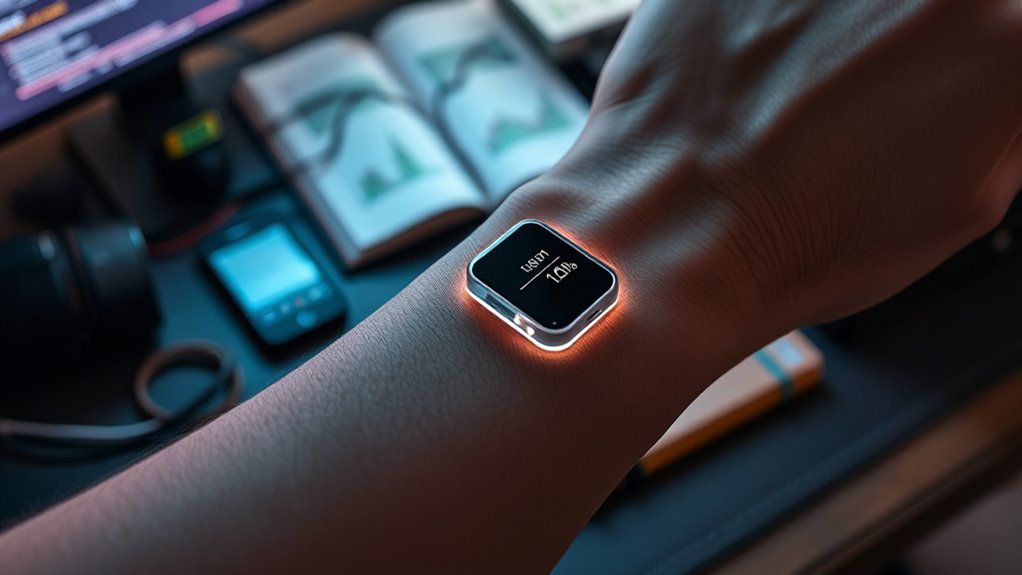
Unlocking the full potential of your CGM requires more than just wearing the device; it involves strategic use of the data it provides. Focus on sensor calibration to guarantee accurate readings, especially if you notice inconsistencies. Use data visualization tools to identify patterns and trends quickly, enabling informed dietary or activity adjustments. Regularly calibrate your sensor as recommended, and leverage apps that display your glucose data visually. This approach helps you spot how specific foods or activities impact your levels. To make it easier, here’s a quick comparison:
| Tip | Benefit |
|---|---|
| Sensor calibration | Guarantees data accuracy |
| Data visualization | Simplifies pattern recognition and decision-making |
Master these techniques to unlock deeper insights and optimize your health journey.
Future Trends and Innovations in Glucose Monitoring
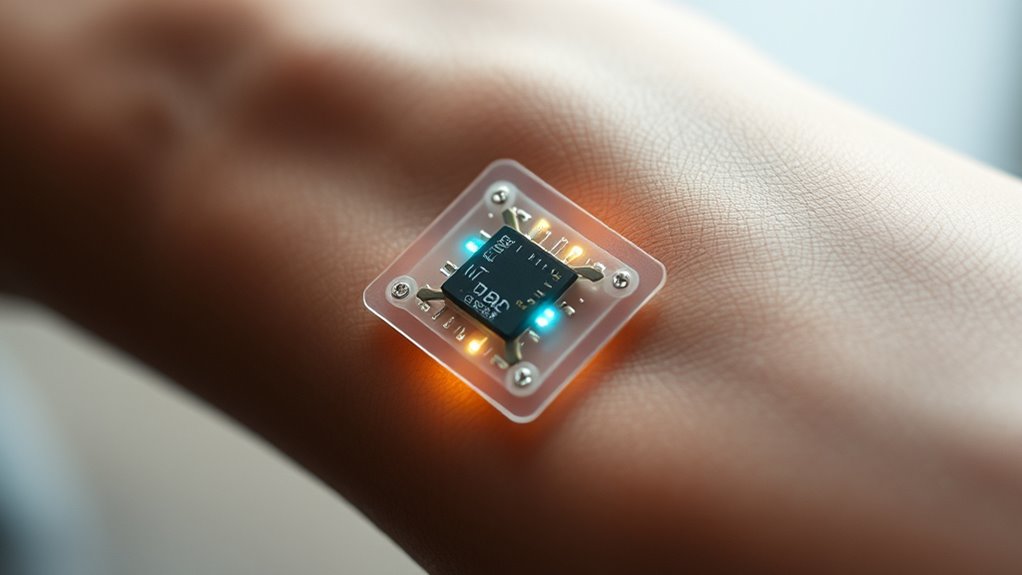
Future innovations in glucose monitoring will focus on making sensors completely non-invasive, so you won’t need to prick your skin anymore. AI-driven data insights will help you understand your glucose patterns better and make smarter health decisions. These advancements promise to make glucose tracking more seamless and personalized for everyone.
Non-Invasive Sensor Development
Could non-invasive glucose sensors soon revolutionize how non-diabetics monitor their health? Advances in sensor durability and wireless connectivity are making this possible. Researchers are developing skin patches, optical sensors, and even saliva-based devices that don’t require needles. These innovations aim for longer-lasting sensors that stay accurate over time. Wireless features allow real-time data sharing with smartphones and health apps, giving you instant insights. Imagine tracking your glucose levels throughout the day without discomfort or downtime. The goal is seamless integration into daily life, making health monitoring effortless. As technology progresses, non-invasive sensors will become more reliable, affordable, and user-friendly. This means you’ll soon have a powerful tool to optimize your health proactively, all without invasive procedures.
AI-Driven Data Insights
As AI technology advances, it’s transforming how glucose monitoring systems interpret and utilize data. You’ll benefit from smarter insights that can detect patterns and predict fluctuations with greater precision, thanks to improved sensor accuracy. These AI-driven tools analyze your data in real-time, helping you make informed lifestyle choices. However, data privacy remains a key concern; developers are working to guarantee your sensitive health information stays secure while enabling personalized recommendations. Future innovations may also include adaptive algorithms that learn your unique physiology, enhancing accuracy over time. As these technologies evolve, you’ll have more reliable, private, and actionable glucose insights at your fingertips, empowering you to optimize your health proactively.
Frequently Asked Questions
Is CGM Data Accurate for Non-Diabetic Blood Sugar Levels?
You might wonder if CGM data accurately reflects your blood sugar levels, especially for detecting glucose fluctuations. While sensors are generally reliable, they can have minor inaccuracies due to sensor accuracy limitations or calibration issues. For non-diabetics, CGMs provide valuable insights into your glucose patterns, but keep in mind that slight variations may occur. Overall, they’re a useful tool, but it’s wise to interpret the data with some caution.
Can CGM Help Improve Athletic Performance or Endurance?
Worried CGM won’t boost your athletic edge? It actually can help by tracking blood sugar fluctuations that influence muscle glycogen and metabolic flexibility. By monitoring these levels, you learn when to fuel or recover, optimizing endurance and performance. This real-time data empowers you to fine-tune your nutrition and training strategies, making your workouts more efficient and effective. So yes, a CGM can give you a competitive advantage.
What Are the Privacy and Data Security Concerns With CGM Devices?
When using CGM devices, you should be aware of privacy and data security concerns. Device hacking is a risk, so make certain your device has strong security measures. Data encryption protects your glucose data from unauthorized access, but vulnerabilities can still exist if updates aren’t applied or if the device’s security protocols are weak. Always keep your firmware updated and use secure, private networks to minimize these risks.
How Often Should Non-Diabetics Calibrate Their CGM Devices?
When it comes to calibration frequency, you’re better off playing it safe than sorry. For non-diabetics, calibrate your CGM device as recommended by the manufacturer, usually once a week or if you notice discrepancies. Regular calibration helps guarantee data accuracy, so you get reliable readings to optimize your health. Don’t ignore the small details; they make all the difference in keeping your biohacking game on point.
Are There Any Long-Term Health Risks From Continuous Glucose Monitoring?
You might wonder about long-term health risks from continuous glucose monitoring, but current research shows that device safety is generally high. While some minor skin irritation can occur, serious health issues are rare. However, it’s wise to monitor how your body responds over time and stay informed about new developments. Overall, the benefits of tracking glucose levels often outweigh potential long-term health concerns, especially if used properly.
Conclusion
Did you know that over 80% of biohackers report improved health and performance using CGM data? By understanding your glucose patterns, you can fine-tune your diet, exercise, and lifestyle for ideal results. Incorporating continuous glucose monitoring into your routine isn’t just for diabetics anymore—it’s a game-changer for anyone seeking to unseal their body’s full potential. Start exploring your data today and take control of your health like never before.
